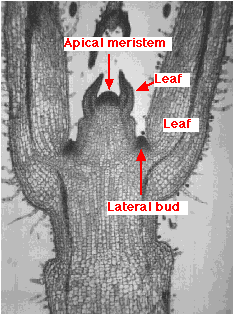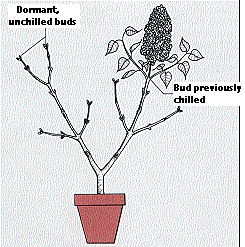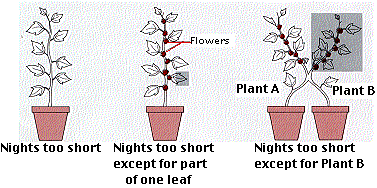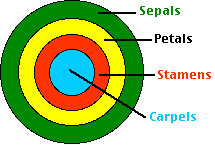| Index to this page |
 The flowering plants (angiosperms) go through a phase of vegetative growth — producing more stems and leaves — and a flowering phase where they produce the organs for sexual reproduction.
The flowering plants (angiosperms) go through a phase of vegetative growth — producing more stems and leaves — and a flowering phase where they produce the organs for sexual reproduction.
Vegetative growth of the above-ground part of the plant — the shoot — occurs at the apical meristem. This is a mass of undifferentiated cells at the tip of the stem. Mitosis of these cells produces cells that differentiate to form
| Discussion of vegetative plant growth |
Flowering involves the conversion of the apical meristem into a floral meristem, from which all the parts of the flower will be produced.
Signals that change the fate of the apical meristem include:Many annual plants (e.g., winter wheat) and biennial plants have their time of flowering delayed unless they have undergone a preceding period of wintertime cold. The change brought about by this prolonged exposure to the cold is called vernalization.
In the "model" plant Arabidopsis thaliana, vernalization works like this.
The buds of many species of woody angiosperms found in temperate climates, such as apples and lilacs, also need a preceding period of cold weather before they can develop into flowers. So these plants cannot be grown successfully at lower latitudes because the winters never get cold enough (a few days at 0–10°C).
This bud dormancy is localized. Prior chilling of one bud on a lilac stem enables it to flower while the other, nonchilled, buds on the stem remain dormant.
Photoperiod is detected in the leaves. The cocklebur, drawn here, needs at least 8.5 hours of darkness in order to flower. Even if only a part of one leaf is exposed to the correct photoperiod, the entire plant will bloom (middle figure).

The leaves produce a chemical signal — called florigen — that is transmitted to the apical meristems to start their conversion into floral meristems. The right-hand drawing shows that grafting a cocklebur (B) that receives the required period of darkness to one (A) that does not causes flowering in both. Evidently the florigen signal passes from B to A through their connected vascular systems.
| Link to a discussion of photoperiodism. |
The chemical nature of florigen has been sought for decades. The most recent evidence suggests that at least one component is the protein encoded by the gene FLOWERING LOCUS T (FT).
When conditions are favorable, e.g., temperature and/or day length, the companion cells of the phloem in the leaves synthesize florigen and release it into the sieve elements. These transport it to the cells of the apical meristem. In the nucleus of the meristem cells, the FT protein binds to the transcription factor FD and turns on the expression of genes needed for flowering, e.g., APETALA1 and LEAFY.
 The floral meristem differentiates into four concentric groups of cells that form the four parts of the flower.
The floral meristem differentiates into four concentric groups of cells that form the four parts of the flower.
What triggers the various parts of the floral meristem to enter one or another of these four developmental pathways?
 These are the rules:
These are the rules:
| A group | APETALA1 (AP1) and APETALA2 (AP2) |
| B group | APETALA3 (AP3) and PISTILLATA (PI) |
| C group | AGAMOUS (AG) |
The transcription factor LEAFY plays a major role in turning on the A, B, and C group genes in the appropriate locations.
If LEAFY protein alone is sufficient to turn on AP1, why isn't AP1 expressed in all four whorls?
The answer: AGAMOUS blocks the expression of AP1, so any cell expressing AGAMOUS cannot express AP1.
In fact, the antagonism is reciprocal: AP2 in whorls 1 and 2 (A group) inhibits AGAMOUS so the gene expression in whorls 3 and 4 remains distinct from that in whorls 1 and 2.
The proteins encoded by APETALA3 and PISTILLATA (Group B) form a heterodimer that binds to
Aided by a fourth transcription factor encoded by the gene SEPALLATA3, these quaternary complexes bind to specific sequences of DNA turning on the expression of the various genes needed to form whorls 2 and 3. Further research may reveal similar behavior for the other genes.
| SEPALLATA3 (SEP3) is one of four SEP genes in Arabidopsis. If all but SEP4 are inactivated, a flower with only sepals is formed (hence the name). If all four are inactivated, no flowers are formed at all. |
So formation of a flower requires a cascade of sequential gene activity that gradually converts a mass of undifferentiated cells (the apical meristem) into the parts of a flower. The genes encode transcription factors that act as master switches, turning on (or off) downstream genes that ultimately make each part of the flower in its appropriate location.
This same strategy of genetic control of developmental pathways is seen in animal development. Try this link to see some examples in Drosophila.
Recommended reading: The Genetics of Flower Development by Elliot M. Meyerowitz (in whose lab many of these discoveries were made). It was published in the November 1994 issue of Scientific American.
| Welcome&Next Search |